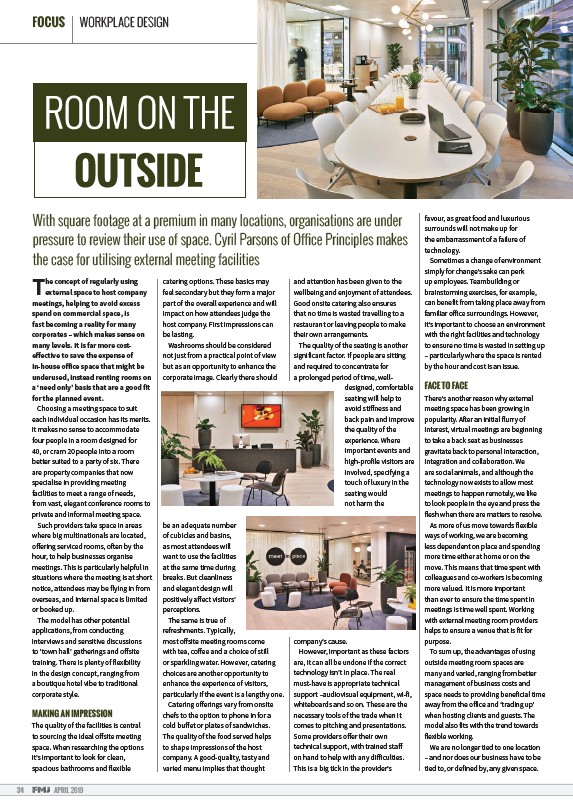
FOCUS WORKPLACE DESIGN
The concept of regularly using
external space to host company
meetings, helping to avoid excess
spend on commercial space, is
fast becoming a reality for many
corporates – which makes sense on
many levels. It is far more coste
ective to save the expense of
in-house o ice space that might be
underused, instead renting rooms on
a ‘need only’ basis that are a good fit
for the planned event.
Choosing a meeting space to suit
each individual occasion has its merits.
It makes no sense to accommodate
four people in a room designed for
40, or cram 20 people into a room
better suited to a party of six. There
are property companies that now
specialise in providing meeting
facilities to meet a range of needs,
from vast, elegant conference rooms to
private and informal meeting space.
Such providers take space in areas
where big multinationals are located,
o ering serviced rooms, o¡ en by the
hour, to help businesses organise
meetings. This is particularly helpful in
situations where the meeting is at short
notice, attendees may be flying in from
overseas, and internal space is limited
or booked up.
The model has other potential
applications, from conducting
interviews and sensitive discussions
to ‘town hall’ gatherings and o site
training. There is plenty of flexibility
in the design concept, ranging from
a boutique hotel vibe to traditional
corporate style.
MAKING AN IMPRESSION
The quality of the facilities is central
to sourcing the ideal o site meeting
space. When researching the options
it’s important to look for clean,
spacious bathrooms and flexible
34 APRIL 2019
catering options. These basics may
feel secondary but they form a major
part of the overall experience and will
impact on how attendees judge the
host company. First impressions can
be lasting.
Washrooms should be considered
not just from a practical point of view
but as an opportunity to enhance the
corporate image. Clearly there should
be an adequate number
of cubicles and basins,
as most attendees will
want to use the facilities
at the same time during
breaks. But cleanliness
and elegant design will
positively a ect visitors’
perceptions.
The same is true of
refreshments. Typically,
most o site meeting rooms come
with tea, co ee and a choice of still
or sparkling water. However, catering
choices are another opportunity to
enhance the experience of visitors,
particularly if the event is a lengthy one.
Catering o erings vary from onsite
chefs to the option to phone in for a
cold bu et or plates of sandwiches.
The quality of the food served helps
to shape impressions of the host
company. A good-quality, tasty and
varied menu implies that thought
and attention has been given to the
wellbeing and enjoyment of attendees.
Good onsite catering also ensures
that no time is wasted travelling to a
restaurant or leaving people to make
their own arrangements.
The quality of the seating is another
significant factor. If people are sitting
and required to concentrate for
a prolonged period of time, welldesigned,
comfortable
seating will help to
avoid sti ness and
back pain and improve
the quality of the
experience. Where
important events and
high-profile visitors are
involved, specifying a
touch of luxury in the
seating would
not harm the
company’s cause.
However, important as these factors
are, it can all be undone if the correct
technology isn’t in place. The real
must-have is appropriate technical
support –audiovisual equipment, wi-fi,
whiteboards and so on. These are the
necessary tools of the trade when it
comes to pitching and presentations.
Some providers o er their own
technical support, with trained sta
on hand to help with any di iculties.
This is a big tick in the provider’s
favour, as great food and luxurious
surrounds will not make up for
the embarrassment of a failure of
technology.
Sometimes a change of environment
simply for change’s sake can perk
up employees. Teambuilding or
brainstorming exercises, for example,
can benefit from taking place away from
familiar o ice surroundings. However,
it’s important to choose an environment
with the right facilities and technology
to ensure no time is wasted in setting up
– particularly where the space is rented
by the hour and cost is an issue.
FACE TO FACE
There’s another reason why external
meeting space has been growing in
popularity. A¡ er an initial flurry of
interest, virtual meetings are beginning
to take a back seat as businesses
gravitate back to personal interaction,
integration and collaboration. We
are social animals, and although the
technology now exists to allow most
meetings to happen remotely, we like
to look people in the eye and press the
flesh when there are matters to resolve.
As more of us move towards flexible
ways of working, we are becoming
less dependent on place and spending
more time either at home or on the
move. This means that time spent with
colleagues and co-workers is becoming
more valued. It is more important
than ever to ensure the time spent in
meetings is time well spent. Working
with external meeting room providers
helps to ensure a venue that is fit for
purpose.
To sum up, the advantages of using
outside meeting room spaces are
many and varied, ranging from better
management of business costs and
space needs to providing beneficial time
away from the o ice and ‘trading up’
when hosting clients and guests. The
model also fits with the trend towards
flexible working.
We are no longer tied to one location
– and nor does our business have to be
tied to, or defined by, any given space.
With square footage at a premium in many locations, organisations are under
pressXre to revieZ their Xse of space. &yril 3arsons of 2Ɲ ce 3rinciples PaNes
the case for utilising external meeting facilities